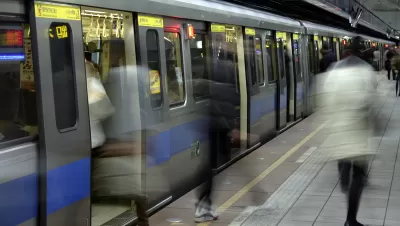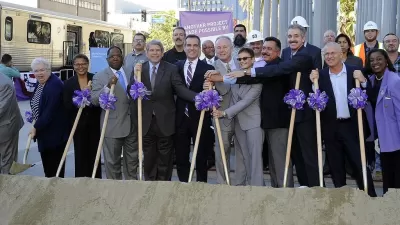Ridership declines mean falling revenues for transit agencies, and could be the beginning of a cycle of service cuts and fare increases leading to yet more ridership declines.

Around the United States, transit ridership is falling. Disappearing bus riders in particular have driven big drops in Miami, Philadelphia, Los Angeles and 31 of 35 large American metro areas. "Researchers concluded factors such as lower fuel costs, increased teleworking, higher car ownership and the rise of alternatives such as Uber and Lyft are pulling people off trains and buses at record levels," Faiz Siddiqui reports for The Washington Post.
The issue isn't merely that ridership is down around the country, but that this drop in ridership may lead to a vicious cycle. "The problem: The declines mean a decrease in farebox recovery, which can often lead to fare increases and reduced service, as in Metro’s case," Siddiqui writes.
"Exceptions to the trend: Seattle, Phoenix and Houston, which either expanded transit coverage and boosted service or underwent ambitious network overhauls, as in Houston’s case," Siddiqui reports. While improving services by reorganizing them or investing in expansions boosted their ridership, it didn't eliminate all the problems associated with cars. "[Seattle], which has some of the worst traffic congestion in the country, hosts about 45,000 Amazon employees and had added 60,000 workers to its center city core since 2010, according to Andrew Glass-Hastings, Director of Transit and Mobility for the Seattle Department of Transportation."
FULL STORY: Falling transit ridership poses an ‘emergency’ for cities, experts fear

Study: Maui’s Plan to Convert Vacation Rentals to Long-Term Housing Could Cause Nearly $1 Billion Economic Loss
The plan would reduce visitor accommodation by 25,% resulting in 1,900 jobs lost.

North Texas Transit Leaders Tout Benefits of TOD for Growing Region
At a summit focused on transit-oriented development, policymakers discussed how North Texas’ expanded light rail system can serve as a tool for economic growth.

Why Should We Subsidize Public Transportation?
Many public transit agencies face financial stress due to rising costs, declining fare revenue, and declining subsidies. Transit advocates must provide a strong business case for increasing public transit funding.

How to Make US Trains Faster
Changes to boarding platforms and a switch to electric trains could improve U.S. passenger rail service without the added cost of high-speed rail.

Columbia’s Revitalized ‘Loop’ Is a Hub for Local Entrepreneurs
A focus on small businesses is helping a commercial corridor in Columbia, Missouri thrive.

Invasive Insect Threatens Minnesota’s Ash Forests
The Emerald Ash Borer is a rapidly spreading invasive pest threatening Minnesota’s ash trees, and homeowners are encouraged to plant diverse replacement species, avoid moving ash firewood, and monitor for signs of infestation.
Urban Design for Planners 1: Software Tools
This six-course series explores essential urban design concepts using open source software and equips planners with the tools they need to participate fully in the urban design process.
Planning for Universal Design
Learn the tools for implementing Universal Design in planning regulations.
Ascent Environmental
Borough of Carlisle
Institute for Housing and Urban Development Studies (IHS)
City of Grandview
Harvard GSD Executive Education
Toledo-Lucas County Plan Commissions
Salt Lake City
NYU Wagner Graduate School of Public Service



























